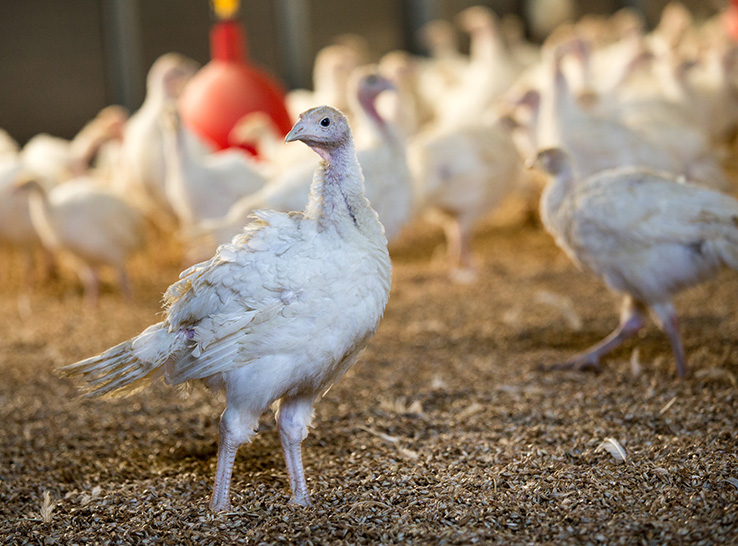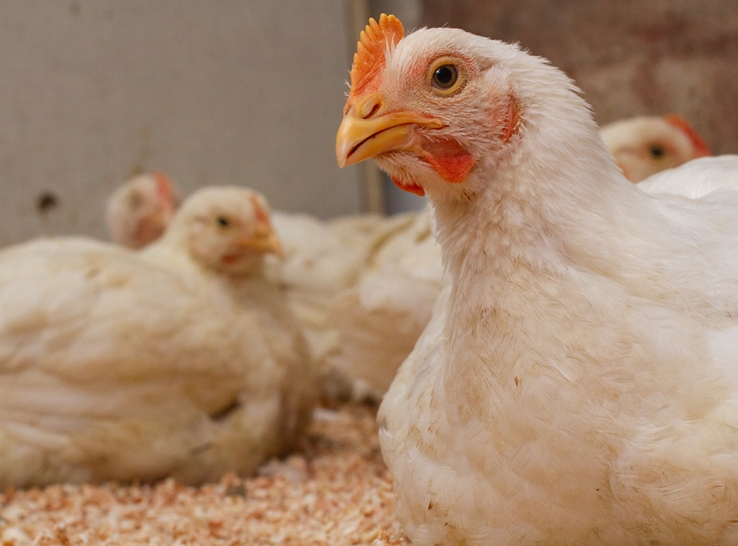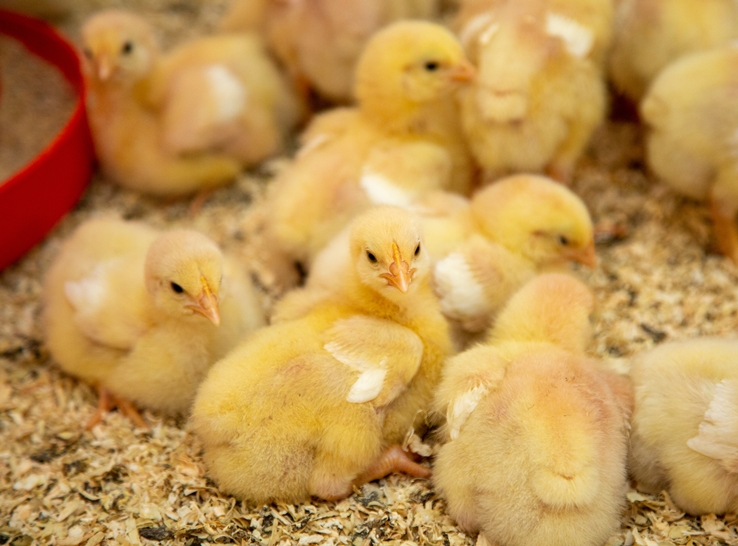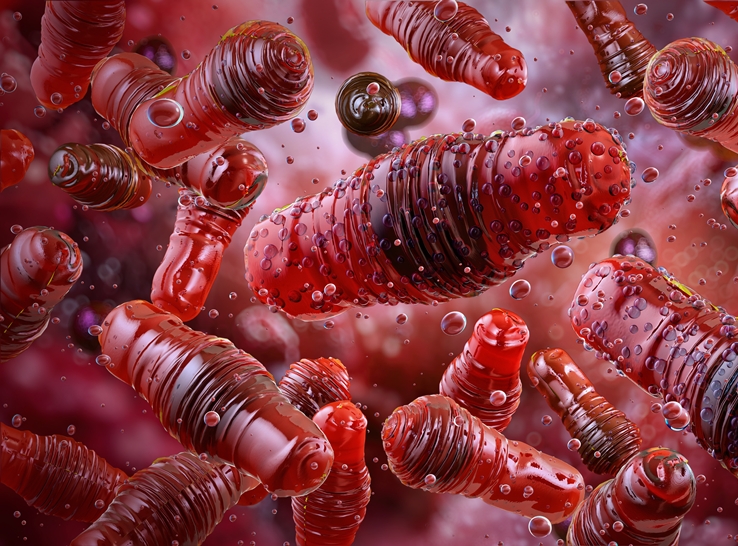Gangrenous dermatitis is a major commercial turkey-production disease, causing significant economic losses annually from increased bird deaths and condemnations at the processing plant. Although multiple bacteria are implicated in dermatitis, the primary cause is Clostridial species, specifically Clostridium septicum.
Dermatitis manifests as fever, ataxia and recumbency. Affected turkeys also have subcutaneous edema with dark reddish-purple or greenish discoloration to the skin and muscle.
“The pathology of how this bacterium exactly causes dermatitis in turkeys is unclear,” reported Meagan Abraham, DVM, PhD, Jennie-O Turkey Store, at the 2024 American Association of Avian Pathologists conference. “There are two prevailing theories.”
Inside-out, outside-in
The inside-out theory involves factors that weaken the bird’s immune system, such as stress or immunosuppression from hemorrhagic enteritis virus or reticular endotheliosis, allowing the bacteria to flourish.
It’s also possible that intestinal lesions allow bacteria to leach out of the gut to cause pathology, Abraham noted. Practical applications have focused on enteric health to reduce bacterial leaching through the intestine.
The premise of the outside-in theory is that bacteria exist in the litter. Then, as birds sit on the litter, bacteria travel through skin lesions. In this case, poor litter conditions may predispose birds to dermatitis, making litter management key to preventing and eliminating bacteria spread.
Litter-management strategies include picking up dead birds so the bacteria do not leach out of them and into the litter.
“We know that litter management is important, whether it’s for dermatitis and Clostridial species or things like Salmonella and Escherichia coli,” Abraham said. She pointed to studies showing that high litter pH and high moisture content are associated with high bacterial loads.
“The highest bacteria load is found in the upper layers of litter,” she added. “So, with reused litter, as more layers are created, the top layers will contain the most bacteria.”
Testing a litter amendment
Abraham and her team evaluated a litter amendment that contained beneficial bacteria, including Bacillus, Pseudomonas, Arthrobacter, Enterococcus, Flavobacterium, cyanobacteria and Actinomyces. The product was developed to control odor and ammonia while digesting organic waste materials.
“The product was also promoted to bloom and grow within the litter and potentially outcompete pathogenic bacteria like Clostridium, Salmonella and E. coli,” she noted.
They hypothesized that the litter product would reduce ammonia levels, moisture and dermatitis incidence.
The team selected a farm with a history of dermatitis. Four barns were designated treatment barns, with an additional four as controls. The study followed two rounds of production. Before the first trial, all eight barns were fully cleaned.
For the first trial, the researchers applied litter amendment to the four treatment barns at a rate of 1 gallon per 1,000 square feet. They reapplied the product to those barns midway through the grow-out period, which ran from 6 to 21 weeks of age.
In the second trial, the researchers partially cleaned the control barns and applied the litter amendment at the same rate used in the first trial. In the treatment barns, they reused the litter, with the amendment reapplied before the birds’ placement. All eight barns received the product again midway through grow-out. This time, the trial ran from 6 to 16 weeks of age.
Data and results
The team collected daily ammonia readings and used the hand-grab method to evaluate litter moisture every other week. This method uses a score of 0 to 4, where 0 is perfectly dry, 3 has some clumping and sticking but no liquid and 4 is sticky litter with liquid present. They collected samples from nine areas within the barn and averaged the scores.
The results showed definite differences in dermatitis incidence between trial 1 and trial 2. Averaged across all eight barns for both trials, the control group reported dermatitis at 127 days of age versus 118 to 120 days for the treatment group.
“This difference in dermatitis incidence equated to significant differences in treatment costs,” Abraham noted. “For the first trial, the cost for the treatment group was about $5,000 more than the control group. In the second trial, the cost was about $24,500 more.”
She pointed out that one barn in the control group never developed signs of dermatitis, which may have skewed the results slightly.
In trial 1, litter moisture averaged a score of 1 for all barns but increased to a score of 2 in trial 2 with reused litter. Notably, the litter-moisture difference between the control and treatment groups was only significant in trial 2.
Ammonia levels revealed differences between trial 1 and trial 2. In trial 1, the treatment group recorded lower ammonia levels than the control group; in trial 2, the control group had lower ammonia levels.
“Although the amendment kept ammonia in check during the first trial, that was not the case in the second trial,” Abraham noted. “In part, that was likely because the control barns received an application in trial 2.”
There was no difference in gain per day between the control and treatment groups in either trial. For bird livability, there were no differences between the two groups in trial 1. However, in trial 2, the control group recorded higher livability.
The feed-conversion ratio (FCR) was lower for the control group in trial 1, but the opposite effect occurred in trial 2, where the treatment group performed better. “The trial 2 FCR results are not statistically significant,” Abraham noted, “but from a practical standpoint, this would make a difference on the farm.”
“Although we hoped the litter amendment would have promising results because it consisted of good bacteria, it did not lower ammonia, moisture or dermatitis incidence,” she concluded.







